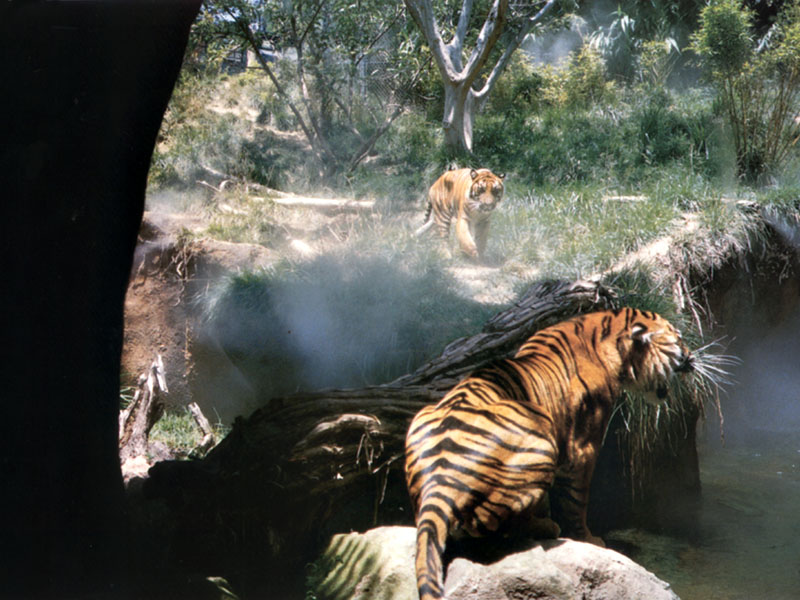|
WILD CATS PART ONE
Tigers :-
The worlds few remaining wild tigers face total extinction over the next decade unless
governments make a major effort to save them. Tiger parts are widely used in the manufacture of traditional Chinese medicines,
some of which are also in demand in Western countries.
But the animal is also declining in numbers because of pressure
on its natural habitat and the disappearance of other species on which it preys, as humans move into previously uninhabited
areas.
As recently as 50 years ago, eight tiger subspecies roamed throughout Asia. Now only five remain. Human pressures
from hunting and habitat destruction exterminated the Balinese, Caspian, and Javan tigers in this century. Based on tiger's
reproductive success rate when the animal and its habitat is left unmolested, the tiger as a species is in its evolutionary
prime. (The same can not be said of the Panda, for example.) Thus, if the tigers were to disappear, the blame would squarely
be place upon the human shoulders.
India, being home to about 60% of the world's wild tiger population, is now the best
hope for tiger survival. The Indian tiger is under severe pressure from habitat reduction and poaching for Traditional Chinese
Medicine. With only 2000-3000 tigers left in severely fractured habitats in India, there is a distinct threat that the wild
tiger could collapse into the extinction vortex in the near future and disappear forever.
In a country that has
3% of the earth's landmass and 20% on its human population, it is a wonder that the Indian subcontinent has provided the wild
tiger's safe haven.

Tigers usually live alone in what is called their "territory". When they are old enough, they choose a place that
has plenty of food, usually about 10 to 30 square miles. Tigers mark their territory by spraying bushes and trees. They use
a combination of urine and scent gland secretions. When another Tiger smells this scent, he knows he that he is in someone
elses territory. Most Tigers are fiercely protective of their territories. Male Tiger's will usually share small sections
of their territories with other female Tigers. The only time that adult Tigers live together is during the breeding season.
Tigers can mate at any time during the year. A female tiger may be able to mate for only three to seven days so the pair will
mate several times to make sure the female will be pregnant. The gestation period would last about three months which three
or four blind cubs are born.
They are nursed for two weeks until their eyes and teeth begin to grow. After about six
months, when the cubs stop feeding on the mother's milk, they start to go out hunting with their mother. When they are two
years old, they can kill larger prey, but they will not leave their mother until they are three to five years old and go out
to search for their own territories and mates.
Of the eight original subspecies of tigers, three have become extinct
in the last 60 years, an average of one every 20 years:
Bali tiger -- extinct in the 1930s
Caspian tiger
-- extinct in the 1970s
Javan tiger -- extinct in the 1980s
The number of tigers in the 1900's --over 100,000
-- dropped to 4,000 in the 1970's. Today, the total of all the wild populations of the five remaining subspecies (Bengal(India),
Indo-Chinese, Siberian, South China, and Sumatran) is an estimated 4,600 and 7,700 tigers. It is known that all remaining
tigers live in small, isolated populations in widely scattered reserves. The largest concentration of tigers in one reserve
is about 250.
The Bengal Tiger
Scientific Name: Panthera tigris tigris
Range: Bangladesh, Bhutan,
India, Myanmar, Nepal
Average Weight:
Female: 221 - 353 Pounds
Male: 419 - 569 Pounds
Average Length:
Female: 7 Feet 11 Inches - 8 Feet 7 Inches
Male: 8 Feet 8 Inches - 10 Feet 2 Inches
Prey: Antelope, Buffalo,
Cattle, Deer, Pigs.
Gestation period: Approximately 103 days
Cubs per litter: 1-5
Average: 2-3
Cub
Maturity:
After 8 Weeks: join mother when hunting
Approximately 6 Months: learned how to kill
11/4 - 11/2 Years:
can hunt for themselves
Status:
1998 Approximates 3,176 - 4,556
1997 Approximates 3,000 - 4,700
Other
Information:
1) Also known as the Royal Bengal Tiger.
2) Also known as the Indian Tiger.
3) All white tigers
are Bengals. All white Bengals in captivity in the USA originated from one white male bengal captured in India in 1951 and
inbred with his offspring. Only Bengal tigers have the double recessive gene that causes the white coloring. White tigers
are not albino.
4) There are more Bengal tigers than all 4 of the other remaining tiger subspecies added together.
The Indochinese Tiger
Scientific Name: Panthera tigris corbetti
Range: Cambodia, Lao PDR, Malaysia,
Myanmar, Thailand, Vietnam
Average Weight:
Female: 221 - 287 Pounds
Male: 330 - 430 Pounds
Average Length:
Female: 7 Feet 7 Inches - 8 Feet 8 Inches
Male: 8 Feet 5 Inches - 9 Feet 4 Inches
Prey: Cattle, Deer, Pigs.
Gestation period: Approximately 103 days
Cubs per litter: 1-5
Average: 2-3
Cub Maturity:
After 8
Weeks: join mother when hunting
Approximately 6 Months: learned how to kill
11/4 - 11/2 Years: can hunt for themselves
Status:
1998 Approximates 1,227 - 1,785
1997 Approximates 1,150 - 1,750
The Siberian Tiger
Scientific
Name: Panthera tigris altaica
Range: Mainly eastern Russia; Some in northeastern
China and northern North Korea
Average Weight:
Female: 221 - 368 Pounds
Male: 419 - 675 Pounds
Average Length:
Female: 7 Feet
11 Inches - 9 Feet
Male: 8 Feet 8 Inches - 10 Feet 9 Inches
Prey: Cattle, Deer, Pigs.
Gestation period: Approximately
103 days
Cubs per litter: 1-5
Average: 2-3
Cub Maturity:
After 8 Weeks: join mother when hunting
Approximately
6 Months: learned how to kill
11/4 - 11/2 Years: can hunt for themselves
Status:
1998 Approximates 360 - 406
1997 Approximates 436 - 505
Other Information:
1) Also known as the Amur Tiger.
2) Also known as the
Ussuri Tiger.
3) Also known as the Manchurian Tiger.
4) Also known as the Northeast China Tiger.
5) Largest
of the tiger subspecies.
Man-eating Tigers
Although tiger attacks on humans are unusual, they do occur.
Because the human population in Asia is increasing, farmers and loggers are begining to use areas where tigers live. This
causes increasing conflicts between tigers and humans. It is thought that most tigers who eat humans are sick or injured and
unable to kill their usual prey. Once they have acquired a taste for human beings, however, they will in all likelihood continue
to kill them.
While man-eating tigers are a rarity in most parts of Asia, they are notorious in the Sunderbans, a 4,000
square mile (10,360 sq km) densely forested river delta area in India and Bangladesh that is the home of 250 tigers. No one
lives in the mangrove forests and swamps of the Sunderbans; however people do enter to fish and gather wood and honey. The
Sunderban tigers seem to have targeted humans as prey, and human casualties are reported every year
Several different
methods have been used to combat man-eating tigers in the Sunderbans. One uses human dummies fitted with electric wires from
car batteries which administer a shock when touched by a tiger, training tigers not to attack humans.
In another method,
a mask of a human face is worn on the back of the head, which deters attacks because tigers normally attack from behind.
While this method seemed to work for several years, it appears that some Sunderban tigers may have discovered the trick.

|




